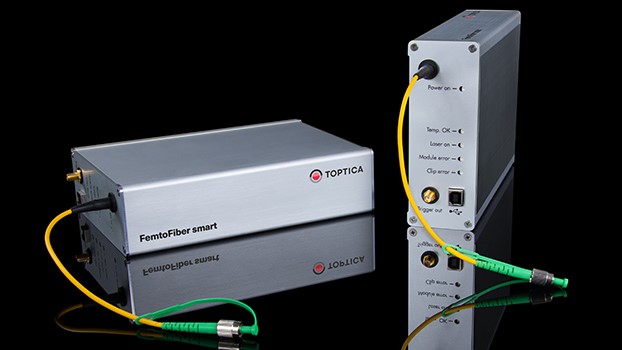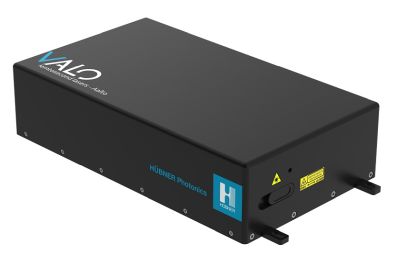master oscillator power amplifier (original) (raw)
Acronym: MOPA
Definition: a laser system consisting of a seed laser and a laser amplifier for boosting the output power
Categories:  laser devices and laser physics,
laser devices and laser physics,  optical amplifiers
optical amplifiers
- master oscillator power amplifier
Related: optical amplifiersmaster oscillator fiber amplifieramplifier noiseDecoupling Pulse Duration and Pulse EnergyWhy Fiber Amplifiers, not Fiber Lasers?All-in-one Concepts versus Modular Concepts
Page views in 12 months: 2825
DOI: 10.61835/11k Cite the article: BibTex BibLaTex plain textHTML Link to this page! LinkedIn
Content quality and neutrality are maintained according to our editorial policy.
📦 For purchasing seed lasers, use the RP Photonics Buyer's Guide — an expert-curated directory for finding all relevant suppliers, which also offers advanced purchasing assistance.
What is a Master Oscillator Power Amplifier?
The term master oscillator power amplifier (MOPA) refers to a configuration consisting of a master laser (or seed laser) and an optical amplifier to boost the output power. A special case is the master oscillator fiber amplifier (MOFA), where the power amplifier is a fiber device. In other cases, a MOPA may consist of a solid-state bulk laser and a bulk amplifier, or of a tunable external-cavity diode laser and semiconductor optical amplifier.
Although a MOPA configuration is more complex than a laser which directly produces the required output power, the MOPA concept can have certain advantages:
- With a MOPA instead of a simple laser oscillator, it can be easier to reach the required performance e.g. in terms of linewidth, wavelength tuning range, beam quality or pulse duration if the required power is very high. This is because various performance aspects are decoupled from the generation of high powers. This gives extra flexibility, e.g. when a gain-switched laser diode (→ picosecond diode lasers) is used as a seed laser. Note also that it can be advantageous to avoid the presence of additional optical components such as wavelength tuning elements in a high-power laser resonator; with a MOPA architecture, one can place these in the oscillator, where they do not have to withstand high optical intensities, do not spoil the power efficiency, etc.
- The same aspects apply to other kinds of modulation, e.g. intensity or phase modulation: it may be advantageous to modulate the low-power seed laser, or to use an optical modulator between seed laser and power amplifier, rather than to modulate a high-power device directly. Slower power modulation may be done by adjusting the amplifier's pump power, without significantly affecting e.g. the obtained pulse duration or wavelength.
- The combination of an existing laser with an existing amplifier (or an amplifier chain) may be simpler than developing a new laser with higher output power.
- The optical intensities are lower in an amplifier, compared with the intracavity intensities in a laser.
However, the MOPA approach can also have disadvantages:
- The complexity of the setup is higher.
- The wall-plug efficiency is often lower. However, it may also be higher, e.g. if that approach allows to remove lossy optical elements from the high-power stage.
- The resulting laser noise tends to be higher, since an amplified source cannot reach the shot noise level (→ amplifier noise). Effects of drifts of the seed power may be suppressed, however, if the amplifier is operated in a strongly saturated regime.
- A MOPA can be highly sensitive to back-reflections, which are amplified again before entering the master laser. This feedback sensitivity can often be cured only by placing a Faraday isolator behind the amplifier. Particularly for high-power pulsed devices, this can introduce serious limitations.
MOPA architectures are also used for pulsed laser sources. In that case, the amplifier may be used as a reservoir of energy. If a pulse from the seed laser extracts a significant fraction of the stored energy, the effect of gain saturation is relevant: the amplifier gain drops during the pulse. This can lead to a deformation of the temporal pulse shape. In some cases, the pulse shape from the seed source is tailored so as to obtain the desired pulse shape after amplification.
Frequently Asked Questions
This FAQ section was generated with AI based on the article content and has been reviewed by the article’s author (RP).
What is a Master Oscillator Power Amplifier (MOPA)?
A Master Oscillator Power Amplifier (MOPA) is a system consisting of a master oscillator (master laser) that produces a high-quality initial laser beam and an optical amplifier that boosts the beam's output power.
What is a major advantage of the MOPA architecture?
A key advantage is the decoupling of performance aspects from high power generation. Characteristics like narrow linewidth, wavelength tuning, and pulse duration can be optimized in the low-power master laser without the constraints imposed by a high-power environment.
What are the common disadvantages of MOPA systems?
How are MOPAs used for pulsed laser sources?
For pulsed sources, the amplifier acts as an energy reservoir. As a pulse extracts energy, the gain drops (gain saturation), which can deform the pulse's temporal shape. This effect can be compensated by tailoring the input pulse shape.
What is a MOFA?
Suppliers
Sponsored content: The RP Photonics Buyer's Guide contains 28 suppliers for seed lasers. Among them:
⚙ hardware
Single-frequency microchip, NPRO and DFB diode CW lasers are available for seeding bulk amplifier chains or fiber amplifiers for generating high power laser radiation at 1030, 1047, 1053, 1064 and 1342 nm wavelengths. Another application is seeding of high-power single-frequency pulsed Q-switched lasers for holographic and interferometric applications.
Picosecond pulse diode lasers from ALPHALAS can be applied for seeding of fiber and regenerative amplifiers.
⚙ hardware
Innolume’s seed laser diodes, operating in the 1015–1125 nm wavelength range, are specifically optimized for fiber laser seeding applications, offering the precision and stability required for high-performance amplification systems.
You can find options including Fabry–Pérot lasers for high-power seeding (up to 1000 mW peak, 400 mW CW) and Distributed Feedback lasers for ultra-short pulse generation down to 50 ps via gain switching.
These sources enable tailored seeding strategies for a wide range of fiber laser architectures.
⚙ hardware
Single frequency fiber lasers exhibit reduced frequency noise, excellent stability and long coherence length due to their short cavity design.
MPBC has a line of short cavity single frequency lasers available at wavelengths ranging from 910 nm to 1300 nm. With an all-fiber optical cavity architecture and a mechanical package that is thermally and acoustically isolated, these lasers are known for their quality and robustness. Active stabilisation implementing Pound–Drever–Hall (PDH) locking is used to stabilise frequency. Wavelength tunability is achieved by temperature and piezo.
These seed lasers can be used in conjunction with MPBC's single frequency amplifiers to increase the output power while maintaining the critical seed parameters, such as narrow linewidth, reduced frequency noise and long coherence lengths.
⚙ hardware
Thorlabs manufactures an extensive selection of ultrafast lasers and related products for control and characterization. Applications from nonlinear excitation and amplifier seeding to THz and supercontinuum generation are served by a family of products covering a spectral range from 700 — 4500 nm. Our femtosecond laser offerings include fiber lasers, and our picosecond lasers include gain-switched and microchip lasers. Complementing these laser systems is a suite of ultrafast optics, including nonlinear crystals, chirped mirrors, low-GDD optics, and related products for pulse measurement, pre-compensation, and dispersion measurement.
⚙ hardware
Menlo Systems' femtosecond fiber lasers based on Menlo figure 9® patented laser technology are unique in regard to user-friendliness and robustness. We offer solutions for scientific research as well as laser models engineered for OEM integration.
⚙ hardware
TOPTICA’s ultrafast fiber lasers family “FemtoFiber smart” is available as picosecond or femtosecond version. The lasers are based either on ytterbium-doped or erbium-doped fiber laser architecture. These systems are dedicated to applications ranging from seed laser purposes, biophotonics to terahertz generation and two-photon polymerization.
⚙ hardware
The VALO Series of ultrafast fiber lasers offers a range of high-performance features suitable for advanced applications in multiphoton imaging, spectroscopy, and more. These compact, turn-key lasers deliver some of the shortest pulse durations and highest peak powers available in fiber laser technology.
Key Specifications:
- Pulse duration: <40 fs
- Output power: up to 2 W
- Noise level: very low
- Features an integrated pre-compensation dispersion module for optimal peak power delivery
Ideal as seed lasers for various amplifier systems, the VALO Series utilizes innovative fiber laser technology to achieve ultrashort pulse durations. This capability, combined with computer-controlled group velocity dispersion pre-compensation, ensures precise peak power delivery exactly where needed.
For more details on how the VALO Series can enhance your application, visit our product page.
⚙ hardware
Serving North America, RPMC Lasers offers precision seed lasers with narrow linewidth and single longitudinal mode (SLM) for high spectral purity, customizable wavelengths, and powers to optimize amplification with reduced gain thresholds.
Flexible fiber-coupling includes single- and multimode options, stabilized and ruggedized for lab or field use, with adjustable pulse widths and rep rates for versatile seeding in stable, reliable setups.
Turnkey solutions deliver high-peak power and low jitter in compact, low-SWaP designs, featuring user-friendly controls and diagnostics for synchronized, high-performance applications.
Let RPMC help you find the right seed laser today!
Questions and Comments from Users
Here you can submit questions and comments. As far as they get accepted by the author, they will appear above this paragraph together with the author’s answer. The author will decide on acceptance based on certain criteria. Essentially, the issue must be of sufficiently broad interest.
Please do not enter personal data here. (See also our privacy declaration.) If you wish to receive personal feedback or consultancy from the author, please contact him, e.g. via e-mail.
By submitting the information, you give your consent to the potential publication of your inputs on our website according to our rules. (If you later retract your consent, we will delete those inputs.) As your inputs are first reviewed by the author, they may be published with some delay.














